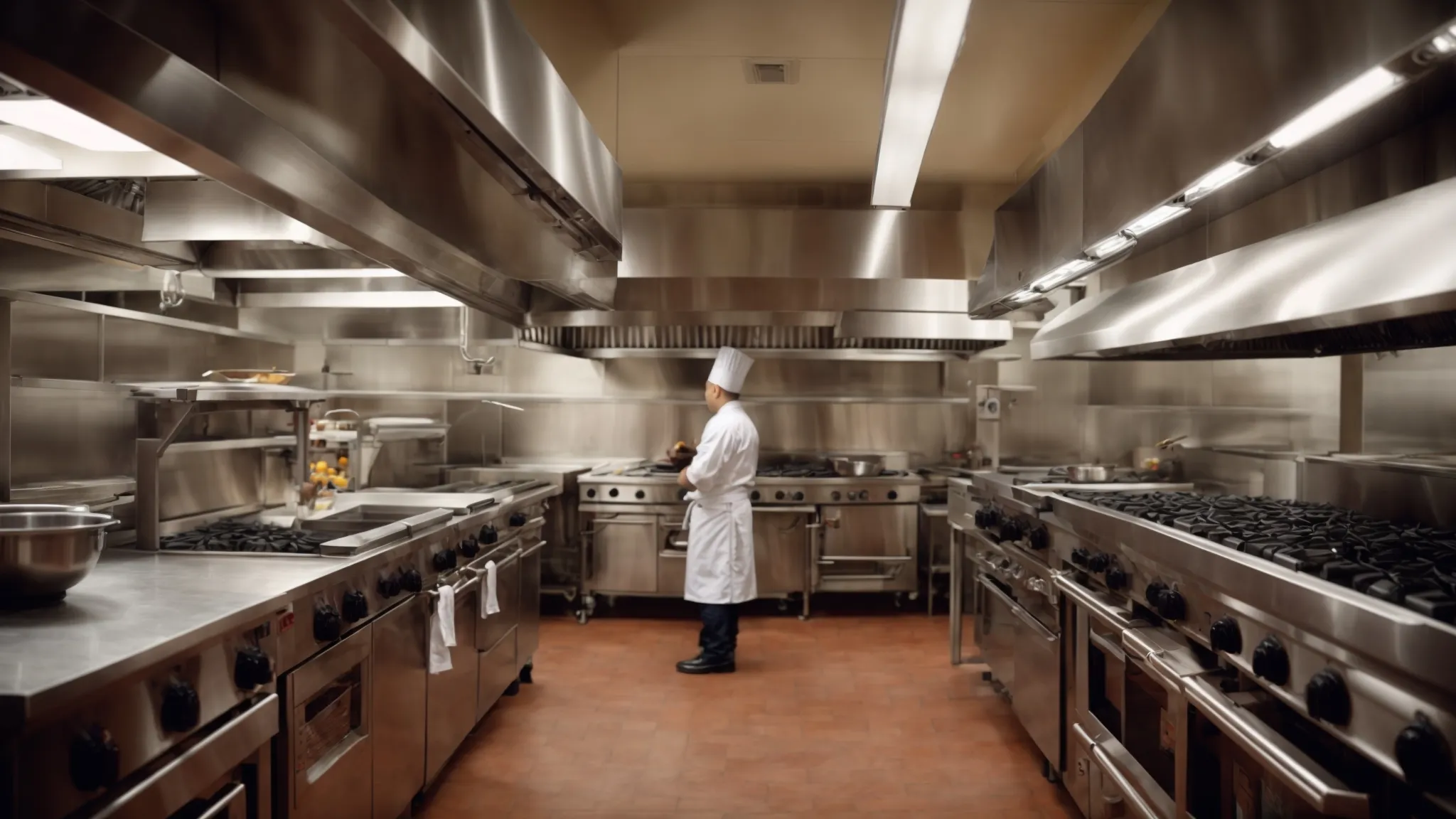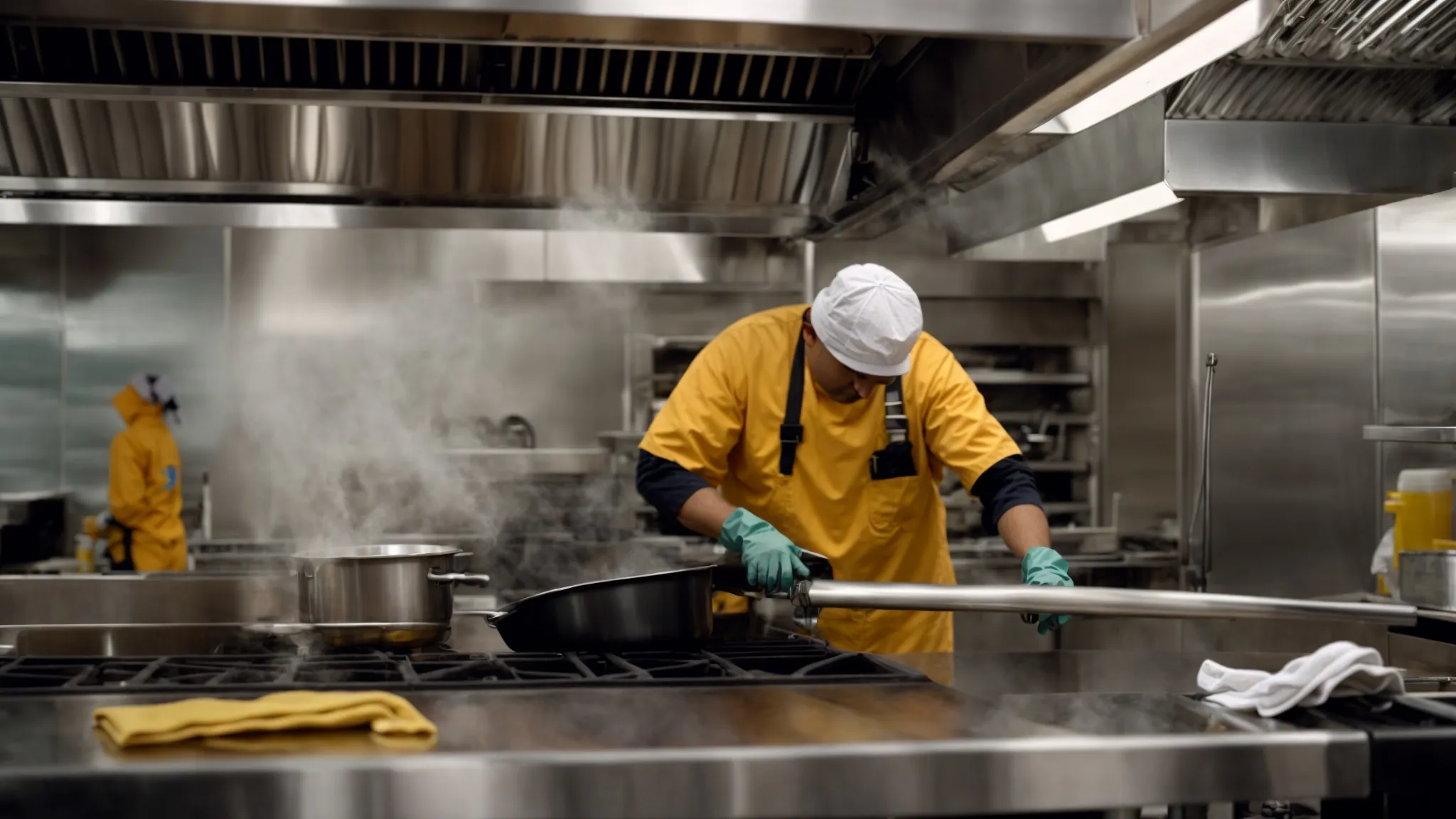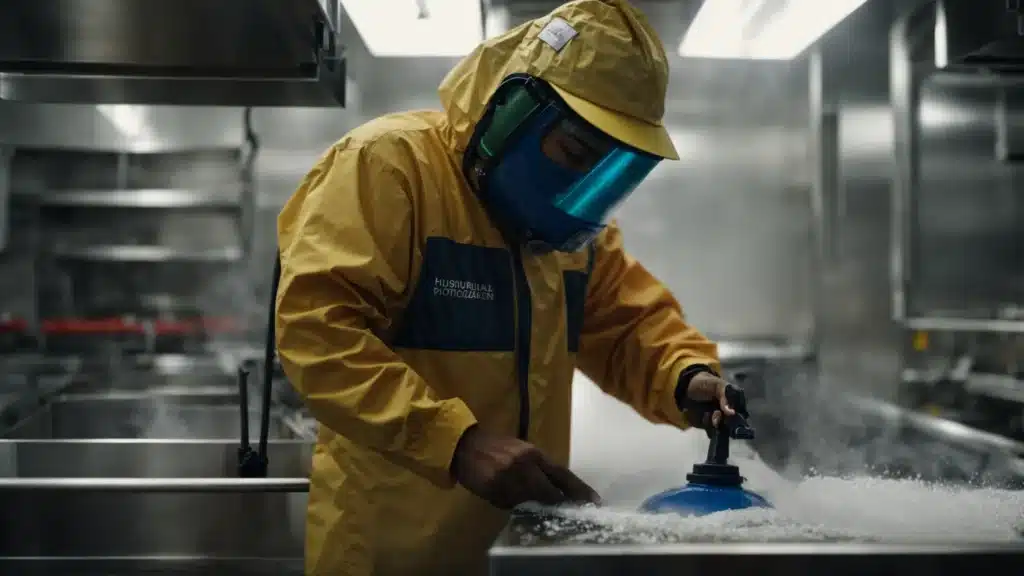Combating Common Hood and Kitchen Exhaust Cleaning Myths
Debunking Popular Myths About Hood and Kitchen Exhaust Cleaning
Navigating through the labyrinth of myths surrounding hood and kitchen exhaust cleaning is akin to embarking on a culinary detective journey, seeking the truth amidst a sea of misconceptions.
From the frequency of cleaning to the supposed efficacy of DIY methods, these myths cloak the reality of what it truly takes to maintain a pristine and safe commercial kitchen.
Debunking these myths not only illuminates the path to better health and safety standards but also unveils the intricacies involved in keeping a kitchen’s air quality at its zenith.
Together, let’s cut through the grease of misinformation and shine a light on the facts.
Keep reading to uncover the truths that will elevate your understanding and approach to hood and kitchen exhaust maintenance.
Key Takeaways
- Scheduled Hood and Kitchen Exhaust Cleaning Is Crucial for Fire Safety and Operational Efficiency
- Professional Cleaning Offers More Than Surface-Level Cleanliness, Including Air Quality Improvement and Fire Risk Reduction
- The Use of Milder, Yet Effective, Cleaning Solutions Can Protect Equipment and Staff Health Without Compromising Cleanliness
- DIY Cleaning Methods Fall Short of the Expertise and Equipment That Professionals Offer, Increasing the Risk of Fire and System Damage
- Tailored Cleaning Strategies Are Imperative for the Diverse Designs and Needs of Different Kitchen Exhaust Systems
Exposing the Myths Around Hood Cleaning Frequency
Toronto Hood Cleaning
In the labyrinthine world of commercial kitchen maintenance, the frequency of hood and kitchen exhaust cleaning dances on the thin line between myth and critical safety protocol.
Bursting the bubble of common misconceptions, many hold the belief that the cue for cleaning is an overt layer of dirt or grease.
This notion, as convenient as it sounds, plays Russian roulette with fire hazards, inviting risk with open arms.
Scheduled cleaning is not just a tick on a checklist; it is a stalwart guardian against potential infernos.
The often-overlooked character in this narrative is the kitchen’s usage itself.
Like a silent sentinel, it dictates the rhythm at which cleaning intervals should be set, ensuring the safety and efficiency of the culinary arena are not compromised.
This discourse will peel away layers of myth, revealing why adhering to professional guidelines for cleaning frequency is not just beneficial but essential for the integrity of any commercial kitchen.
Myth: It’s Enough to Clean When It Looks Dirty
In the meticulous domain of commercial kitchen care, an all-too-common fallacy rides the currents of misconception: the idea that the grimy evidence of dirt and grease serves as the sole herald for the necessity of hood and kitchen exhaust cleaning. This misguided belief is not just erroneous but dangerously simplifies a complex issue, casting a shadow on the critical nuances of maintaining safety and cleanliness.
This misjudgment sidesteps the intricate dance of variables that dictate the precise moments when an exhaust system deserves attention. Factors such as the volume of cooking, the types of food prepared, and the equipment used converge to form a more reliable indicator of cleaning needs:
| Type of Operations | Average Cleaning Frequency |
|---|---|
| High-volume Restaurant | Every month |
| Mid-volume Cooking | Every 3 months |
| Low-volume Kitchens | Every 6 months |
Fact: Scheduled Cleaning Prevents Fire Hazards
Embedding the truth in the heart of commercial culinary practices, scheduled hood and kitchen exhaust cleanings stand as the bulwark against the spark that can ignite disaster. It acts as a forceful extinguisher, snuffing out the lurking threats of fire hazards with the precision of a skilled surgeon.
This methodical approach to cleanliness transforms a restaurant’s kitchen from a potential tinderbox into a domain of safety and assurance. For every globule of grease and every waft of hazardous fume, there’s a regimen of cleaning that ensures they remain harbingers of delicious meals, not ominous warnings of fire:
- The removal of oily residues and buildup significantly decreases the probability of kitchen fires.
- Professional inspections and cleanings unearth hidden risks within the ductwork and exhaust systems.
- Ensuring that ventilation equipment operates at peak efficiency promotes a healthier, safer working environment for staff.
The Role of Kitchen Usage in Determining Cleaning Intervals
The role kitchen usage plays in determining the intervals for hood and kitchen exhaust cleaning is akin to the pace set by a seasoned conductor for an orchestra, ensuring each section comes in at the right moment. The sheer volume of culinary activities, ranging from simmering stews to flaming grills, orchestrates a unique rhythm that calls for a customized cleaning schedule, tailored to the kitchen’s specific operational tempo.
Understanding the dynamics of kitchen usage allows Ontario Hood Cleaning to craft bespoke cleaning regimes that align with the heartbeat of each commercial kitchen. This nuanced approach ensures that no corner of the kitchen dances in the shadows of neglect, with every sizzle and sauté factored into the equation, thereby guaranteeing both safety and optimal functionality.
As we peel back the layers on hood cleaning myths, a surprising truth emerges. Brace yourself; we’re diving into the murky waters of caustic chemicals next.
The Truth About Using Caustic Chemicals for Cleaning

The campaign against grime in the commercial kitchen often falls prey to the myth that the fiercest warriors are those wielding the most potent chemicals.
However, navigating the battle against oil, grease, and contaminants requires precision and wisdom, not just brute strength.
This section delves into the misconception that stronger chemicals guarantee a superior clean, dispelling such beliefs with evidence that champions proper cleaning techniques over the severity of chemicals used.
It further unveils the significant health and safety considerations that accompany the use of caustic agents, bringing to light the implications these substances have not only on the kitchen environment but also on the wellbeing of those who breathe life into it every day.
Myth: Stronger Chemicals Ensure a Better Clean
A common misconception sails across the commercial kitchen seas, where it’s believed that the strength of chemicals used in hood and kitchen exhaust cleaning is directly proportional to the level of cleanliness achieved. This belief is not anchored in reality, as it overlooks the artistry and precision required in tackling the greasy adversaries that lurk in commercial kitchens.
Contrary to this widely held myth, employing milder yet effective solutions coupled with meticulous techniques often results in a superior clean, without the collateral damage associated with aggressive chemicals. This approach safeguards not only the integrity of kitchen equipment but also the health of the heroic staff who operate within these culinary battlefields daily.
Fact: Proper Techniques Are More Important Than Harsh Chemicals
In the intricate theater of commercial kitchen maintenance, the spotlight shines not on the might of caustic chemicals, but on the nuanced choreography of proper cleaning techniques. Embracing this philosophy, Ontario Hood Cleaning champions a methodical approach, leveraging a symphony of specialized equipment and refined methods to tackle the stubborn foe of kitchen grime without resorting to the harsh embrace of potent substances.
This strategic preference for technique over toxicity embodies a deep understanding that true cleanliness extends beyond superficial appearances, reaching into the very air breathed by the kitchen brigade. By prioritizing delicate yet effective cleaning solutions and practices, the company ensures that both the kitchen’s heart and its lifelines—vents and exhausts—are preserved, promising not just a clean but a vibrant cooking haven free from the unnecessary hazards introduced by aggressive cleaning agents.
The Health and Safety Implications of Chemical Use
The health and safety implications of utilizing strong caustic chemicals for hood and kitchen exhaust cleaning cannot be overstated: such practices often do more harm than good. The aggressive nature of these agents can corrode equipment surfaces, compromise the structural integrity of ventilation systems, and create hazardous by-products that contaminate the kitchen atmosphere.
| Chemical Type | Equipment Impact | Atmospheric Impact |
|---|---|---|
| Strong Acids/Bases | Corrosion and Long-term Damage | Creation of Harmful By-products |
| Mild Detergents | Preserves Integrity | Maintains Clean Air Quality |
Besides the tangible effects on kitchen infrastructure, the health of staff working within these environments is significantly at risk. Inhalation of fumes from harsh cleaning chemicals can lead to a spectrum of respiratory problems, acute skin reactions, and even long-term health issues, emphasizing the need for safer, environmentally friendly cleaning alternatives.
The journey from harsh chemicals to homemade solutions takes an unexpected turn. Buckle up as we delve into the reality behind DIY kitchen exhaust cleaning prowess.
Debunking DIY Kitchen Exhaust Cleaning Effectiveness

In the odyssey of maintaining a pristine commercial kitchen, a prevalent myth whispers that the do-it-yourself (DIY) approach mirrors the efficacy of seasoned professionals.
This belief, however, glosses over the chasm between the makeshift tools of an amateur and the advanced arsenal at a professional’s disposal.
It underestimates the alchemy of expertise and specialized equipment that professionals bring to the battle against grease and grime.
As we navigate through the mist of misconceptions, we’ll uncover the stark disparities between DIY endeavors and professional mastery, shedding light on the unseen risks that lurk within amateur cleaning attempts.
Myth: DIY Is Just as Effective as Professional Services
The illusion that Do-It-Yourself (DIY) approaches can match the caliber of professional kitchen exhaust cleaning services persists as a mirage in the desert of commercial kitchen maintenance. This myth embellishes the capabilities of amateur efforts, disregarding the chasm of difference in the results achieved by seasoned professionals versus home remedies.
Ontario Hood Cleaning’s refined techniques and specialized equipment stand as the knights in stainless steel armor, battling against the dragon of contamination and grease. The story unfolds as follows:
- Amateurs often lack the intricate knowledge of ventilation systems that professionals possess.
- Using inadequate tools and methods may lead to incomplete removal of grease, thereby increasing the risk of fire.
- Professional services ensure a thorough clean, maintaining optimal kitchen safety and compliance with health regulations.
While the allure of DIY projects holds a certain charm for the budget-conscious restaurateur, the oversight in recognizing the sophistication required in exhaust cleaning spills into dangerous territory. Misplaced confidence in DIY efforts can not only compromise the safety of a commercial kitchen but also its compliance with stringent health standards.
Fact: Professionals Have Specialized Equipment and Expertise
The arsenal at a professional’s disposal is not just a collection of tools; it’s a meticulously assembled array of specialized equipment and refined expertise, designed to combat the toughest kitchen exhaust challenges. These high-caliber instruments, from industrial-grade degreasers to advanced centrifugal fans, work in concert with the skilled hands that wield them, ensuring a level of cleanliness beyond the reach of amateur attempts.
| Professional Equipment | DIY Alternatives | Effectiveness |
|---|---|---|
| Industrial-grade degreasers | Household cleaning solutions | Highly effective vs. Minimal impact |
| Advanced centrifugal fans | Basic fans or none | Optimized airflow vs. Inadequate ventilation |
| Specialized brushes and tools | Generic cleaning tools | Thorough cleaning vs. Surface-level effort |
In this symphony of cleanliness, expertise plays a pivotal role: it guides the orchestration of these tools to reach every nook and cranny, ensuring not a speck of grease remains. This expertise is not merely knowledge; it’s the culmination of years of experience and training, a stark contrast to the hit-or-miss approach of DIY adventures. The nuance of understanding kitchen exhaust systems inside and out allows professionals to diagnose and resolve issues that would otherwise go unnoticed by the untrained eye.
Risks Associated With Amateur Cleaning Attempts
Embarking on a journey to cleanse a commercial kitchen’s exhaust system unaided is akin to navigating a ship through a storm without a compass. Such ventures often lead to overlooked grease accumulation, creating an invisible yet imminently ignitable hazard. This oversimplified approach, lacking professional depth, inadvertently sets the stage for potential disaster, as even small oversight can spell the difference between safety and calamity.
Moreover, amateur cleaning attempts frequently result in damage to the delicate components of the exhaust system. Utilizing inappropriate cleaning agents or tools can cause corrosion or dislodgement, impairing the system’s efficiency and potentially incurring costly repairs or replacements. The pursuit of a quick fix may thus evolve into a financial and operational quagmire, emphasizing the false economy of DIY kitchen exhaust cleaning endeavors.
Now, let’s turn our attention from the myths surrounding DIY kitchen exhaust cleaning. Prepare to delve into the labyrinth of components and challenges that make up your hood and exhaust systems.
Understanding the Complexity of Hood and Exhaust Systems

In navigating the intricate maze of hood and kitchen exhaust cleaning, a pervasive myth claims a one-size-fits-all approach suffices.
Contrary to this simplification, the truth reveals a panorama of systems, each with its unique habitat, demanding tailored strategies for cleanliness.
The recognition of this diversity underscores the criticality of devising bespoke cleaning plans, meticulously crafted to address the varying demands of different ventilation setups.
Dismissing the idiosyncrasies of each system not only jeopardizes the effectiveness of cleaning efforts but also overlooks the opportunity to enhance the longevity and efficiency of these essential kitchen allies.
Myth: All Kitchen Exhaust Systems Are the Same
The myth that all kitchen exhaust systems are the same overlooks the intricate dance of engineering and design tailored to each kitchen’s unique needs. Like fingerprints, no two systems share the exact layout, capacity, or challenges, thereby requiring a bespoke approach to maintenance and cleaning that acknowledges these differences.
In dismissing the complexity of hood and exhaust systems, one ignores the orchestra of factors such as airflow dynamics, grease production rates, and environmental considerations that shape their operation. This oversimplification not only undermines the efficiency of cleaning efforts but also risks the system’s integrity and the safety of the kitchen environment.
Fact: Systems Vary and Require Different Cleaning Approaches
Embracing the diversity of kitchen exhaust systems demands specialized cleaning methodologies, tailored to each unique setup. The sweeping assertion that one cleaning strategy fits all belies the nuanced intricacies of varying systems, from the compact ducts in quaint bistros to the sprawling ventilation networks of grand hotel kitchens: each arena plays by its own rules, dictating its distinct cleaning blueprint.
Ontario Hood Cleaning, with its cadre of experts, navigates this labyrinth of diversity with seasoned precision. Acknowledging the individualized nature of each system, the company devises custom cleaning plans that harmonize with the specific requirements of different kitchen exhaust configurations, ensuring efficiency and longevity in their operation:
| Kitchen Type | Exhaust System Complexity | Customized Cleaning Approach |
|---|---|---|
| Quaint Bistro | Compact | Targeted Degreasing |
| Grand Hotel Kitchen | Sprawling | Comprehensive Vent Cleaning |
| Fast Food Chain | High Grease Output | Increased Frequency Maintenance |
Importance of Customized Cleaning Plans
The mosaic of culinary operations demands a palette of customized cleaning plans, acknowledging the diverse nature of each commercial kitchen. Ontario Hood Cleaning weaves these specialized strategies with a thread of expertise, ensuring every kitchen breathes free of grease and contaminants: a testament to its dedication to safeguarding against fire risks and promoting health.
- A meticulous assessment of the kitchen’s volume of activity and the equipment used dictates the frequency and intensity of cleaning required.
- Attention to the specific materials from which exhaust systems are crafted informs the choice of cleaning agents, preventing damage and ensuring longevity.
- Consideration of the kitchen’s layout and the intricacies of its exhaust system guides the deployment of specialized equipment and techniques, optimizing cleanliness and efficiency.
This comprehensive approach to crafting customized cleaning plans not only ensures compliance with regulations but also elevates the safety and operational efficiency of the kitchen. Ontario Hood Cleaning’s commitment to precision and specialization exemplifies its role as a leader in the industry, transforming the narrative of commercial kitchen maintenance.
Navigating the labyrinth of hood and exhaust systems uncovers a world far removed from common knowledge. Next up, we’re venturing into the often misunderstood arena of kitchen exhaust cleaning costs, promising revelations that might just surprise you.
The Misconception About Kitchen Exhaust Cleaning Costs

Amid the swirling myths surrounding hood and kitchen exhaust cleaning, one stands out for its tenacity: the belief that engaging professional services invariably means diving deep into one’s pockets.
This notion casts shadows of hesitation among many, urging them to consider postponing such services in a bid to curtail expenses.
However, this section aims to illuminate the reality that not only does this misconception obscure the actual affordability of professional cleaning, but also veils the undeniable long-term savings that accrue from regular maintenance.
Moreover, the economic repercussions of neglecting the cleaning of kitchen exhaust systems—a gamble with far higher stakes—will be meticulously explored, offering a comprehensive understanding of the true costs and benefits inherent in professional exhaust system upkeep.
Myth: Professional Cleaning Is Always Expensive
The belief that engaging Ontario Hood Cleaning—or similar services—for thorough exhaust and hood cleaning will drain the business coffers is a widely held but flawed perspective. It’s an assertion that clouds the vision of many proprietors, veiling the actual value professional cleaning services contribute towards long-term cost-efficient operations and safety enhancements.
In reality, the investment in professional exhaust system maintenance often aligns more closely with financial prudence than extravagance. Through averting the risks associated with fire hazards and ensuring equipment operates with optimal efficiency, Ontario Hood Cleaning positions itself as a cornerstone in the profitable management of commercial kitchens, dismantling the myth of prohibitive expense.
Fact: The Long-Term Savings of Regular Maintenance
The long-term savings accruing from regular maintenance of hood and kitchen exhaust systems cannot be overstated: It is an investment that pays dividends in efficiency, safety, and compliance. By preventing the accumulative build-up of grease and other flammable substances, Ontario Hood Cleaning ensures that kitchens operate within safety standards, reducing the risk of costly fires and potentially devastating insurance claims.
Apart from mitigating fire hazards, routine cleaning promotes the optimal performance of kitchen equipment, extending its lifespan and curbing the need for expensive repairs or replacements. The act of maintaining clean exhaust systems thus translates into prolonged operational efficiency, which in turn reflects positively on a restaurant’s financial health:
| Aspect of Saving | Benefit |
|---|---|
| Reduced Risk of Fire | Lower Insurance Premiums |
| Extended Equipment Lifespan | Decreased Replacement Costs |
| Optimized Operational Efficiency | Energy Cost Savings |
The Cost of Neglecting Kitchen Exhaust System Cleaning
The dalliance with postponing or entirely overlooking kitchen exhaust cleaning holds far more severe consequences than most appreciate. It’s a gamble that leans heavily towards accumulating grease and debris, setting the stage for catastrophic fire incidents that can devastate both life and property.
Moreover, the stealthy degradation of air quality and system efficiency in such neglected environments ensnares commercial kitchens, leading to a downturn in health standards and a surge in operational costs. These hidden expenses emerge as unforeseen burdens, eroding the very foundation of a kitchen’s profitability and operational excellence.
Shattering misconceptions doesn’t stop with just the price tags. Brace yourself as we debunk another pervasive myth that’s been slicking its way through the conversations about kitchen cleanliness.
Busting the Myth That Cooking Grease Is the Only Concern

Peeling back the layers of kitchen cleanliness myths reveals a stark oversight: the belief that the primary, if not sole, objective of hood and kitchen exhaust system cleaning is the removal of grease.
This narrow viewpoint eclipses the multifaceted benefits that comprehensive cleaning brings, especially in enhancing airflow efficiency and bolstering fire safety measures.
Beyond the ubiquitous grease, a cocktail of other contaminants—ranging from dust particles to carbon deposits—also necessitates meticulous attention during the cleaning process.
Each of these elements, if left unchecked, can significantly compromise the integrity of a commercial kitchen, elevating the risk of fire and diminishing the system’s overall effectiveness.
Myth: Grease Removal Is the Sole Purpose of Cleaning
Many believe that the primary aim of hood and kitchen exhaust cleaning revolves solely around the eradication of cooking grease, an oversimplified narrative that omits the complexity of kitchen maintenance. This singular focus on grease not only disregards the variety of other contaminants that can compromise a kitchen’s operations but also minimizes the holistic benefits of comprehensive exhaust system cleaning.
The reality is that thorough cleaning addresses a spectrum of issues beyond grease, including the removal of dust, carbon deposits, and other particles that could hinder the system’s performance. Ignoring these elements in the cleaning process exposes the kitchen to unnecessary risks of fire and inefficiency, underscoring the critical need for a broader approach to exhaust system maintenance.
Fact: Cleaning Also Addresses Airflow Efficiency and Fire Safety
Ontario Hood Cleaning delves beyond the surface, recognizing that efficient airflow and stringent fire safety are pivotal to the culinary stronghold. By purging vents and ducts of accumulated debris, they enhance the kitchen’s breath, ensuring air moves freely, mitigating the stifling embrace of smoke and odors that could otherwise mar the sanctity of cooking spaces.
This meticulous approach not only elevates indoor air quality but acts as a formidable line of defense against the specter of fires. The removal of not just grease but all forms of combustible residue from kitchen ventilation systems fortifies the culinary arena, safeguarding it from the claws of potential flame outbreaks, thus championing the twin causes of safety and efficiency in commercial kitchens.
Other Contaminants That Need Attention During Cleaning
In the arena of commercial kitchen maintenance, the narrative frequently overlooks the legion of other contaminants that lay siege alongside grease: dust, carbon deposits, and organic matter are formidable adversaries that demand vigilant attention. These silent invaders subtly accumulate, forming a layer of filth that can impede airflow and pose a clandestine threat to fire safety protocols.
Moreover, the presence of bacteria and other microbial threats in kitchen exhaust systems adds a complex layer of risk, not just to the physical infrastructure but also to the health and safety of kitchen staff and patrons. This microbial menace underscores the crucial need for comprehensive cleaning that transcends mere grease removal, ensuring a kitchen environment that is not only safe from fire hazards but also hygienic:
| Contaminant | Impact on Kitchen Safety | Cleaning Priority |
|---|---|---|
| Dust and Carbon Deposits | Impaired Airflow, Increased Fire Risk | High |
| Organic Matter | Decomposition, Odor Problems | Medium |
| Bacteria and Microbes | Health Hazard, Contamination Risk | Critical |

